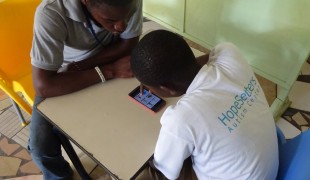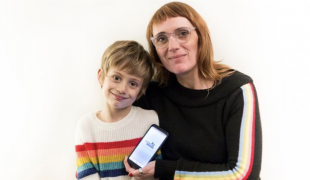- 4404
- 359
- 6
- 10
- 0
- Help Ukraine
About the solution
Scott is a teenager who suffers from autism and is non-verbal. So, his father Alan decided to put his love for invention to use and build him “Scott’s Peg Board”, in the hopes that it would help his son communicate.
The device consists of a board with 16 slots, each one with a picture. When pressed, a corresponding sound is emitted. The pictures and sounds can be changed, producing an almost infinite number of possibilities and exploring several different types of communication. For example, Alain made one set with pictures of animals so that Scott can learn their different sounds. Another one with everyday representation (like objects, emotions, needs and family members photos) that allows for more direct communication: when Scott needs to go to the bathroom he can press the picture of the toilet or when he is thirsty he can press the picture with the drinks.
The whole device is relatively simple and can be made with easy to find materials like copper foil, cardboard and pvc sheets. The electronics are based on an Arduino microcontroller board a Df-player mp3 module. A complete list of materials and instructions can be found at Alain’s website “Alain’s Projects”, where he shares the entire development process.
Instruction and information: https://alainsprojects.com/2020/03/10/scotts-peg-board-communication-board/
https://twitter.com/AlainsProjects/status/1318943509790007296
https://twitter.com/AlainsProjects/status/1236710812619857920?s=20
This solution shall not include mention to the use of drugs, chemicals or biologicals (including food); invasive devices; offensive, commercial or inherently dangerous content. This solution was not medically validated. Proceed with caution! If you have any doubts, please consult with a health professional.
DISCLAIMER: This story was written by someone who is not the author of the solution, therefore please be advised that, although it was written with the utmost respect for the innovation and the innovator, there can be some incorrect statements. If you find any errors please contact the patient Innovation team via info@patient-innovation.com
-
-
359
-
0
-
4735

App for autistics
CAREGIVING
COMMUNICATION: Communicating, whether by speaking, listening, or other means
Playing
Autism
App (Including when connected with wearable)
Educational/Leisure device (book, toy, game...)
Difficulty concentrating or making decisions
Social withdrawal or isolation
Loss of interest or pleasure in activities (anhedonia)
Promoting self-management
Managing Neurological Disorders
Promoting inclusivity and social integration
To improve Treatment/Therapy
Raise awareness
Child and Adolescent Psychiatry
Pediatrics
Ghana
-
-
-
309
-
0
-
3097

Mum develops a digital platform for children to cope with anxiety.
-
-
-
394
-
0
-
5282

Dad combines devices to help disabled child use computers
COMMUNICATION: Communicating, whether by speaking, listening, or other means
Playing
Cerebral Palsy
Assistive Technology access
AI algorithm
Restoring mobility
Promoting self-management
Managing Neurological Disorders
Promoting inclusivity and social integration
Improving Speech and Communication
Preventing (Vaccination, Protection, Falls, Research/Mapping)
Raise awareness
Child and Adolescent Psychiatry
General and Family Medicine
Neurology
Pediatrics
Canada
-
 en
en